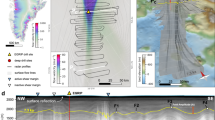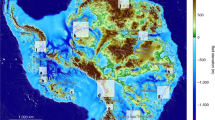Abstract
Marine-based ice streams whose beds deepen inland are thought to be inherently unstable1,2,3. This instability is of particular concern because significant portions of the marine-based West Antarctic and Greenland ice sheets are losing mass and their retreat could contribute significantly to future sea-level rise4,5,6,7. However, the present understanding of ice-stream stability is limited by observational records that are too short to resolve multi-decadal to millennial-scale behaviour or to validate numerical models8. Here we present a dynamic numerical simulation of Antarctic ice-stream retreat since the Last Glacial Maximum (LGM), constrained by geophysical data, whose behaviour is consistent with the geomorphological record. We find that retreat of Marguerite Bay Ice Stream following the LGM was highly nonlinear and was interrupted by stabilizations on a reverse-sloping bed, where theory predicts rapid unstable retreat. We demonstrate that these transient stabilizations were caused by enhanced lateral drag as the ice stream narrowed. We conclude that, as well as bed topography, ice-stream width and long-term retreat history are crucial for understanding decadal- to centennial-scale ice-stream behaviour and marine ice-sheet vulnerability.
This is a preview of subscription content, access via your institution
Access options
Subscribe to this journal
Receive 12 print issues and online access
$259.00 per year
only $21.58 per issue
Buy this article
- Purchase on Springer Link
- Instant access to full article PDF
Prices may be subject to local taxes which are calculated during checkout



Similar content being viewed by others
References
Weertman, J. Stability of the junction of an ice sheet and an ice shelf. J. Glaciol. 13, 3–11 (1974).
Thomas, R. The dynamics of marine ice sheets. J. Glaciol. 24, 167–177 (1979).
Schoof, C. Ice sheet grounding line dynamics: Steady states, stability, and hysteresis. J. Geophys. Res. 112, F03S28 (2007).
Joughin, I., Smith, B. E. & Holland, D. M. Sensitivity of 21st century sea level to ocean-induced thinning of Pine Island Glacier, Antarctica. Geophys. Res. Lett. 37, L20502 (2010).
Rignot, E. Recent Antarctic ice mass loss from radar interferometry and regional climate modelling. Nature Geosci. 1, 106–110 (2008).
Pritchard, H. D., Arthern, R. J., Vaughan, D. G. & Edwards, L. A. Extensive dynamic thinning on the margins of the Greenland and Antarctic ice sheets. Nature 461, 971–975 (2009).
Price, S. F., Payne, A. J., Howat, I. M. & Smith, B. E. Committed sea-level rise for the next century from Greenland ice sheet dynamics during the past decade. Proc. Natl. Acad. Sci. USA 108, 8978–8983 (2011).
Joughin, I. & Alley, R. B. Stability of the West Antarctic ice sheet in a warming world. Nature Geosci. 4, 506–513 (2011).
Mercer, J. H. West Antarctic ice sheet and CO2 greenhouse effect: a threat of disaster. Nature 271, 321–325 (1979).
Powell, R. D. in Glacial Marine Sedimentation: Paleoclimatic Significance Vol. 261 (eds Anderson, J. B. & Ashley, G. M.) 75–94.
IPCC, in Climate Change 2007: The Physical Science Basis (eds Solomon, S. et al.) (Cambridge Univ. Press, 2007).
Pattyn, F. et al. Results of the Marine Ice Sheet Model Intercomparison Project, MISMIP. Cryosphere 6, 573–588 (2012).
Pollard, D. & DeConto, R. Modelling West Antarctic ice sheet growth and collapse through the past five million years. Nature 458, 329–332 (2009).
Hindmarsh, R. C. A. The role of membrane-like stresses in determining the stability and sensitivity of the Antarctic ice sheets: back pressure and grounding line motion. Phil. Trans. R. Soc. A 364, 1733–1767 (2006).
Vieli, A. & Payne, A. J. Assessing the ability of numerical ice sheet models to simulate grounding line migration. J. Geophys. Res. 110, F01003 (2005).
Goldberg, D., Holland, D. M. & Schoof, C. Grounding line movement and ice shelf buttressing in marine ice sheets. J. Geophys. Res. 114, F04026 (2009).
Katz, R. F. & Worster, M. G. Stability of ice-sheet grounding lines. Proc. R. Soc. A 466, 1597–1620 (2010).
Ó Cofaigh, C., Pudsey, C. J., Dowdeswell, J. A. & Morris, P. Evolution of subglacial bedforms along a paleo-ice stream, Antarctic Peninsula continental shelf. Geophys. Res. Lett. 29, 1199 (2002).
Ó Cofaigh, C. et al. Flow dynamics and till genesis associated with a marine-based Antarctic palaeo-ice stream. Quat. Sci. Rev. 24, 709–740 (2005).
Ó Cofaigh, C., Dowdeswell, J. A., Evans, J. & Larter, R. D. Geological constraints on Antarctic palaeo-ice-stream retreat. Earth Surf. Proc. Land 33, 513–525 (2008).
Kilfeather, A. A. et al. Ice-stream retreat and ice-shelf history in Marguerite Trough, Antarctic Peninsula: Sedimentological and foraminiferal signatures. Geol. Soc. Am. Bull. 123, 997–1015 (2011).
Dowdeswell, J. A., Ottesen, D., Evans, J., Cofaigh, C. Ó & Anderson, J. B. Submarine glacial landforms and rates of ice-stream collapse. Geology 36, 819–822 (2008).
Livingstone, S. J. et al. Antarctic palaeo-ice streams. Earth Sci. Rev. 111, 90–128 (2012).
Nick, F. M., Vieli, A., Howat, I. M. & Joughin, I. Large-scale changes in Greenland outlet glacier dynamics triggered at the terminus. Nature Geosci. 2, 110–114 (2009).
O’Neel, S., Pfeffer, W.T., Krimmel, R. & Meier, M. Evolving force balance at Columbia Glacier, Alaska, during its rapid retreat. J. Geophys. Res. 110, F03012 (2005).
Whillans, I. M. & van der Veen, C. J. The role of lateral drag in the dynamics of Ice Stream B, Antarctica. J. Glaciol. 43, 231–237 (1997).
Payne, A. J., Vieli, A., Shepherd, A. P., Wingham, D. J. & Rignot, E. Recent dramatic thinning of largest West Antarctic ice stream triggered by oceans. Geophys. Res. Lett. 31, L23401 (2004).
Price, S. F., Conway, H., Waddington, E. D. & Bindschadler, R. A. Model investigations of inland migration of fast-flowing outlet glaciers and ice streams. J. Glaciol. 54, 49–60 (2008).
Joughin, I. et al. Basal conditions for Pine Island and Thwaites Glaciers, West Antarctica, determined using satellite and airborne data. J. Glaciol. 55, 245–257 (2009).
Ross, N. et al. Steep reverse bed slope at the grounding line of the Weddell Sea sector in West Antarctica. Nature Geosci. 5, 393–396 (2012).
Acknowledgements
We thank T. Pfeffer, T. Payne and R. Hindmarsh for constructive comments. This project was financially supported by the Natural Environment Research Council, UK, grant no. NE/G015430/1.
Author information
Authors and Affiliations
Contributions
S.S.R.J. and A.V. contributed equally to this work. S.S.R.J. completed the numerical modelling and extended the model provided by A.V. S.S.R.J. wrote the first draft and all authors contributed to the analysis, interpretation and the writing of the paper. A.V., C.S., C.Ó.C. and C.D.H. conceived the idea and designed the research. S.J.L. carried out the mapping. C.D.H. and J.A.D. contributed chronological and geophysical data.
Corresponding author
Ethics declarations
Competing interests
The authors declare no competing financial interests.
Supplementary information
Supplementary Information
Supplementary Information (PDF 1267 kb)
Supplementary Movie
Supplementary Movie (MOV 9815 kb)
Rights and permissions
About this article
Cite this article
Jamieson, S., Vieli, A., Livingstone, S. et al. Ice-stream stability on a reverse bed slope. Nature Geosci 5, 799–802 (2012). https://doi.org/10.1038/ngeo1600
Received:
Accepted:
Published:
Issue Date:
DOI: https://doi.org/10.1038/ngeo1600
This article is cited by
-
Rapid, buoyancy-driven ice-sheet retreat of hundreds of metres per day
Nature (2023)
-
A thicker Antarctic ice stream during the mid-Pliocene warm period
Communications Earth & Environment (2023)
-
Development and Benchmarking of the Shallow Shelf Approximation Ice Sheet Dynamics Module
Ocean Science Journal (2023)
-
Stability of the Antarctic Ice Sheet during the pre-industrial Holocene
Nature Reviews Earth & Environment (2022)
-
Holocene reconfiguration and readvance of the East Antarctic Ice Sheet
Nature Communications (2018)



